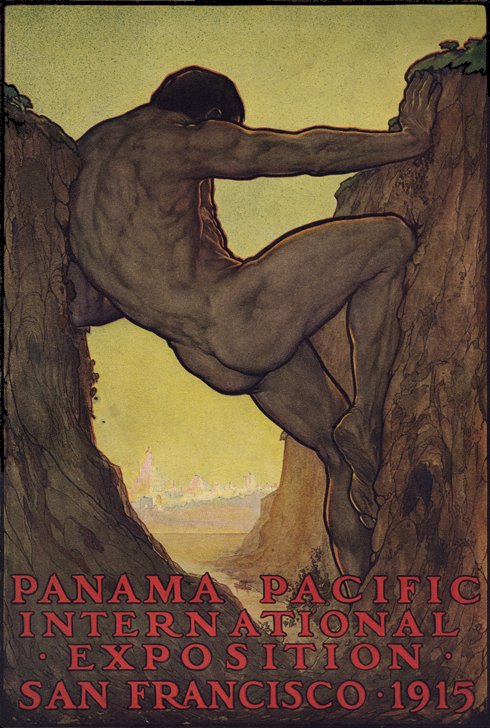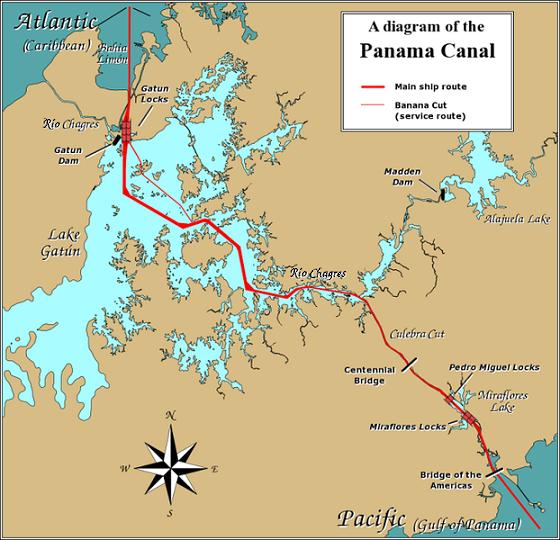The 13th labor of Hercules
by Jason Crawford · September 3, 2018 · 5 min read
Almost a decade ago, I vacationed in Panama. Of course, the thing I was most interested in seeing was the Canal. And of course, in preparation for the trip, I picked up David McCullough’s tome, The Path Between the Seas, a history of its creation.
There are two great canals in the world, because there are two places in the world where a short waterway can separate two entire continents and give ships a shortcut to avoid a lengthy circumnavigation: Suez and Panama. The Suez Canal, built in the 1860s, cuts through Egypt and separates Africa from Eurasia, saving four to five thousand miles on a trip from London to Bombay. Panama, separating North from South America, saves some eight to ten thousand miles on a trip from New York to San Francisco.
In 1898, at the start of the Spanish-American War, the battleship USS Oregon was ordered to Florida from Bremerton, WA. It took over two months to make the 14,000-mile journey (including stops for fuel and supplies). If the Canal had existed, it would have been only 4,000 miles. For this reason, the canal is important not only economically but also militarily, and it was built soon after this episode by the US Army.

Just a few decades before, though, there had been a massive failed attempt at the canal by a French private company. What was fascinating to me was why they failed.
The root cause of the failure was that the project was run, not by an engineer, but by a diplomat, Ferdinand de Lesseps, and not on facts and logic, but on sentiment and blind faith. But the central cause was that the French were trying to build the wrong kind of canal.
De Lesseps insisted on building the canal at sea level—sans écluses, without locks. This is how Suez had been built: just a big trench dug straight through the desert. De Lesseps had been involved in Suez (which may have given him a false sense of confidence) and he felt that this kind of canal was the most elegant.
What he ignored was geography. The site at Panama had two major problems that made a sea-level canal impractical. The first was the mountains: instead of a ditch in the desert, this path would need to blast through rock. But even worse was the mighty Chagres River, which ran right through the proposed path and which was prone to flooding in the rainy season. There was a vague plan to dam the river, but no suitable rock formation to found the dam was ever identified. After years of digging and hundreds of millions of francs spent, the company folded.
The solution to Panama was to discard sentiment and to build a canal with locks. A ship transiting the canal first enters a trench dug at sea level, which takes it part of the way. Then it is raised up 85 feet to the level of Lake Gatun, where it crosses most of the way. Finally, it is lowered back down to sea level, and exits another trench to join the ocean on the other side:

A canal lock is like an elevator for ships. The principle is simple: two dams are constructed across a narrow waterway, close to each other, but with enough space that a ship can fit in between them. The dams separate two bodies of water at diferent levels. Using valves, the space in between is filled or emptied with water in order to raise or lower the water level—the equivalent of an elevator car moving up or down. Each dam has a door that can swing open, when the water level is equalized on either side, to let ships through.
So, to raise a ship to a higher level, say from a sea-level trench to an elevated lake: First, water is let out of the lock if needed to lower the water to sea level. Then, the gates open and the ship enters the lock. The gates are shut behind the ship, which is now enclosed in a small space. Next, the valves that let water out are closed, and the valves that let water in from the lake are opened. Water begins to fill the lock, raising the ship along with the water line. When the water in the lock reaches level of the lake, the gates on the other side open, and the ship can now enter the lake. To lower a ship, the process is reversed.
Panama actually has multiple locks in between the oceans and Lake Gatun. Here’s an animated diagram of a transit:
And here’s a time-lapse of ships going through one lock:
The locks allow the Panama Canal to avoid a path straight through the mountains, and also to take advantage of Lake Gatun to make up about half of the 51-mile journey.
There’s just one catch: When construction began, Lake Gatun did not exist.
Where did it come from? Recall the other problem facing the canal’s engineers: the Chagres River. To build the canal, the river was diverted into a valley, flooding it and creating the lake. Gatun is a man-made lake—at the time, the largest in the world.
The locks also impose a constraint: to make the transit, a ship cannot be too large to fit in them. The maximum size for a ship to fit was known as Panamax: length 950 feet, “beam” (width) 106 feet, “draft” (depth below the water) 39.5 feet. In the mid-20th century, though, with the rise of container shipping, ships were built bigger and bigger for economies of scale. Eventually ships were built that exceeded Panamax and could not go through the Canal; they could only be used for other routes. Because of this, the Panama Canal was expanded between 2007 and 2016, creating a new standard, New Panamax, that allows ships over twice the capacity. However, even before the expansion was open, ships had been built that were even larger than this!
One last story from Path Between the Seas: In addition to the engineering problems, one of the biggest challenges facing the builders was the scourge of tropical diseases. During the French attempt, tens of thousands of workers died from malaria and yellow fever. At the time, the cause of the disease, and the way it spread, were not known. Indeed, the germ theory itself was not yet widely accepted; “miasma” theory was still common, and many blamed the diseases on “bad air” from the jungle being stirred up by construction. It was not understood that the diseases could spread from one person to another, and so in hospitals, patients were grouped in wards not by disease but by race. (!) No one at the time suspected mosquitoes of being the disease vector, and so no attempts were made to eliminate them—in fact, they were inadvertently fostered: to prevent ants from crawling into hospital beds, each foot of the bed was placed in a small pool of water, a perfect breeding ground for mosquitoes. Altogether, if you didn’t have malaria or yellow fever when you entered a hospital, you’d probably get one of them before you left.
Fortunately, around the turn of the century, a few heroic medical pioneers, including Dr. Carlos Finlay and Dr. Walter Reed, discovered that these diseases were caused by bacteria borne by mosquitoes. Through long, painstaking detective work, they uncovered the complicated cycle from human to insect to another human, with multi-day incubation periods required at each step, obscuring the process. They figured out exactly which species of insect carried which disease, and then studied them intensely to understand their mating patterns. Ultimately, the mosquito populations were systematically reduced and their contact with humans prevented. Swamps were drained, and barrels and pots of water were closed or covered with a thin layer of oil. One species could not survive exposure to direct sunlight, so swaths of brush were cleared away to create a moat of uncovered land around each human settlement. Together, these measures dramatically reduced cases of malaria and yellow fever, saving tens of thousands of lives during construction.
Here’s a seven-minute time-lapse video of a full transit from Pacific to Atlantic, which takes about eleven hours:
Relevant books
The Path Between the Seas: The Creation of the Panama Canal, 1870-1914
